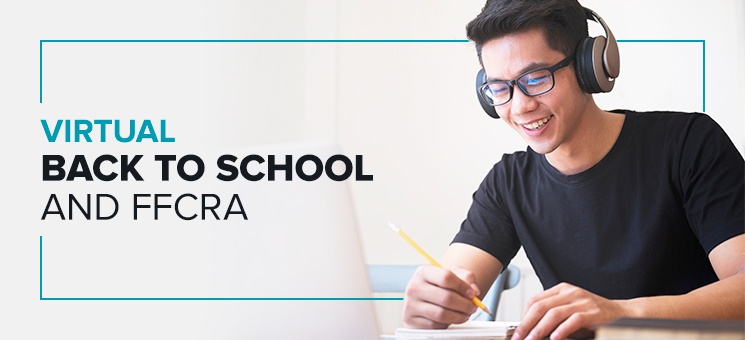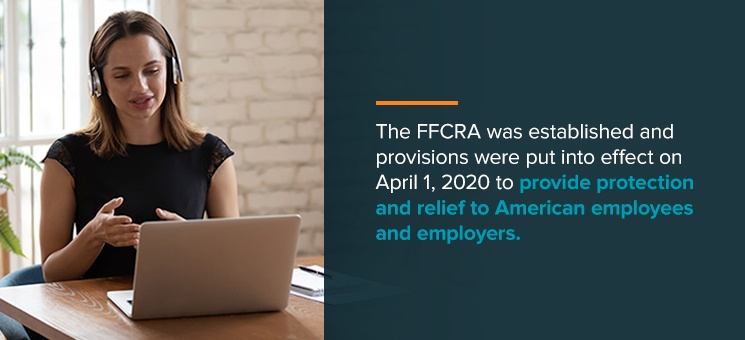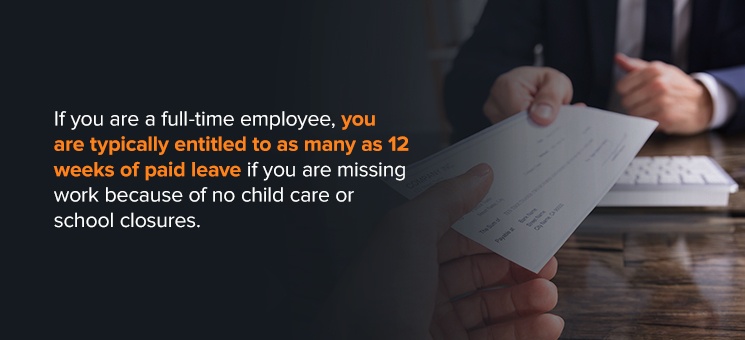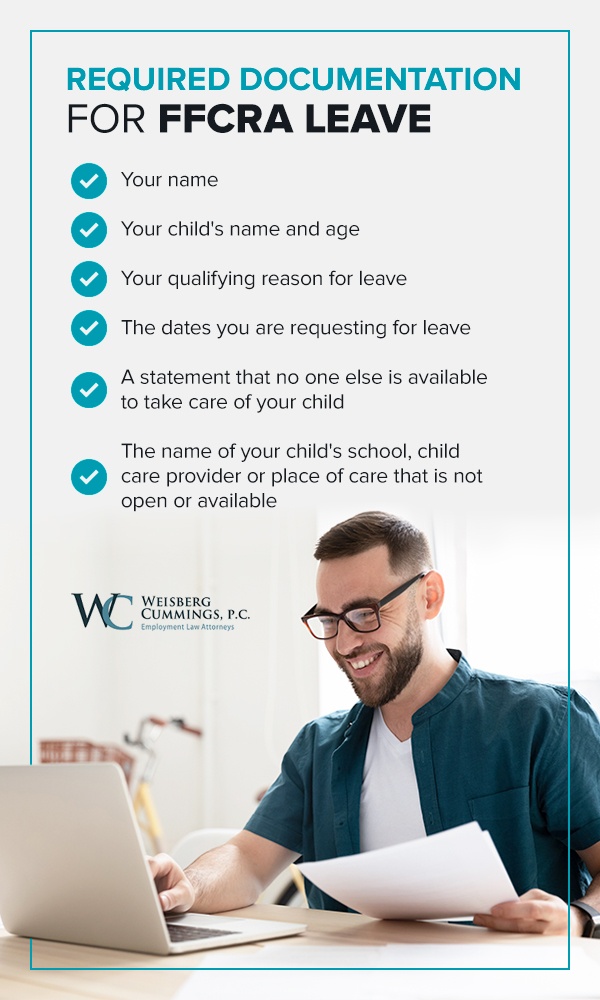By Weisberg Cummings, P.C. on October 26th, 2020
As school districts across the U.S. are starting a new school year, the number of COVID-19 cases is continuing to increase. School districts are using different approaches for reopening for the school year, with some making a full return to the classroom, some taking a hybrid approach and others going entirely virtual.
Regardless of whether some school days are virtual or every day is virtual, many working parents will have to find child care arrangements or stay at home with their children. For these parents, do employers need to accommodate child care? The Families First Coronavirus Response Act, also known as FFCRA, establishes what paid leave employees are entitled to if they are not able to work or work remotely as a result of school closures or the unavailability of child care due to COVID-19.
How FFCRA Works
The FFCRA was established and provisions were put into effect on April 1, 2020 to provide protection and relief to American employees and employers. The U.S. Department of Labor’s Wage and Hour Division administers FFCRA paid leave. FFCRA allows employees to remain on the payroll so they are not forced to decide between getting a paycheck and taking care of their children. The FFCRA provisions will be in effect through December 31, 2020.
Covered Employers
Eligible U.S. employers are those that have fewer than 500 employees. These employers can be reimbursed via tax credits, which allow them to approve workers who want to take paid leave as a result of COVID-19. A covered employer qualifies for reimbursement of all qualifying wages via tax credits up to the aggregate payment caps and appropriate per diem.
A small business that has fewer than 50 employees could be exempt from the mandate to offer leave as a result of unavailable child care or school closings if the requirements for leave would endanger the business’s viability.
Covered Employees
Eligible employees are those who work in the private sector for an employer that has fewer than 500 employees. Certain employees who work in the public sector may also be eligible for partially or fully paid sick leave for a reason related to COVID-19.
To be eligible for FFCRA leave, employees must also be employed by the company for at least 30 days before submitting a leave request. Part-time employees may be able to take leave for a length of time equal to the number of work hours they would normally be scheduled to work over two weeks.
Employee Leave for School Closure Under FFCRA
As an employee, you may be entitled to FFCRA leave if your employer has work available for you, but you are unable to work because of one of the COVID-19 qualifying reasons listed in the FFCRA.
Reasons That Qualify You for Taking FFCRA Leave
Under the FFCRA, you qualify for paid sick time when you are not able to work or work remotely due to one of the following:
- Your doctor has advised you to self-quarantine because of COVID-19.
- You have COVID-19 symptoms and you are seeking a medical diagnosis.
- You are being subjected to an order for isolation or quarantine because of the COVID-19 pandemic.
- You are taking care of a child whose place of care or school is not available or is closed due to COVID-19.
- You are taking care of someone who is subjected to an order to isolate or quarantine or has been advised to self-quarantine by a doctor.
The following are examples of qualifying situations for taking FFCRA leave:
- Your child’s school is going hybrid or entirely virtual: If the school your child attends is going hybrid or entirely virtual with classes, you are entitled under the FFCRA to take paid leave during the days your child stays home.
- A doctor advises your child not to attend due to a medical condition: Additionally, even if your child’s place of child care or school is open, your child’s physician may determine your child is not able to safely attend in person due to a disability or medical condition that puts him or her at greater risk due to COVID-19. In this instance, you may also be entitled to FFCRA leave, as you need to stay home to take care of your child.
Reasons That Do Not Qualify You for FFCRA Leave
The following are examples of reasons that do not qualify you for FFCRA leave:
- Your child’s school is closed for a non-COVID-19 reason: If a school closure is a result of a reason that is not related to COVID-19, like normal closures due to holidays or summer vacation, this is not a qualifying reason for paid leave under the FFCRA.
- Your child’s school offers in-person classes: If your child’s school makes a full return to the classroom or takes a hybrid approach, you cannot take FFCRA leave on the days that in-person classes are available.
- You elect to keep your child home: If you voluntarily choose to keep your child home from school by taking advantage of a virtual class option or by homeschooling when in-person classes are available, you will typically not be eligible for FFCRA leave.
- You can work while your child is home: You also may not be eligible for FFCRA leave if you are able to work while your child is home. If your child is an older teenager, for example, he or she can be left home alone or can be unsupervised while you telework. However, a child being older does not automatically disqualify you from taking FFCRA leave, as you may still need to care for an older child during the day.
Ultimately, you typically qualify for FFCRA leave if your child’s care or school is closed due to COVID-19, while you typically cannot take FFCRA leave if you voluntarily elect for what you believe is the best child care or school option for your child.
How Much Paid Leave Are Parents and Guardians Entitled to Under FFCRA?
If you are a full-time employee, you are typically entitled to as many as 12 weeks of paid leave if you are missing work because of no child care or school closures. This is the case as long as you choose to use your available emergency paid sick leave to substitute for the initial two weeks of expanded family medical leave (FMLA).
If you have not used any regular FMLA during your employer’s FMLA year, you may be eligible for 10 additional weeks of paid expanded family medical leave if you are not able to work because you need to take care of a child whose child care provider or school is closed due to COVID-19. The pay during this leave is two-thirds of your regular pay, but no more than $200 per day.
Under the FFCRA, employers should provide all employees with one of the following:
- Two weeks of paid sick leave at your regular rate of pay: You can get paid at your regular rate of pay or the minimum wage rate, whichever is greater, for up to 80 weeks if you are not able to work due to quarantine orders, seeking a medical diagnosis or experiencing symptoms of COVID-19. You can get paid a maximum of $511 a day and $5,110 over a two-week period.
- Two weeks of paid sick leave at two-thirds of your regular rate of pay: You can get paid at two-thirds of your regular pay rate or the rate of the minimum wage, whichever is greater, if you are not able to work because you need to take care of someone who is subject to quarantine or care for a minor child whose child care provider or school is closed or unavailable due to COVID-19. You can get paid a maximum of $200 a day and $2,000 over a two-week period.
Part-time employees who qualify for leave can take leave for the number of hours they would typically be scheduled for during that period.
Required Documentation for FFCRA Leave
Taking FFCRA leave is not as simple as contacting your employer and requesting the day off. The documentation and information you are required to provide to take FFCRA include the following:
- Your name
- Your child’s name and age
- Your qualifying reason for leave
- The dates you are requesting for leave
- A statement that no one else is available to take care of your child
- The name of your child’s school, child care provider or place of care that is not open or available
If you are claiming an inability to work due to the need to care for a child who is older than 14, you must also provide a statement about the special circumstances that require you to provide care to the child.
Your employer should be flexible in the type of documentation he or she will accept so you can satisfy these requirements. For example, you may choose to provide a publicly available document or share a letter from the school district about student schedules regarding school closures. Additionally, if a third-party document is unavailable, you may be able to submit a written statement about the school closure.
Can Parents and Guardians Working From Home Take FFCRA Leave?
Whether you will be able to take FFCRA leave if you can work from home is dependent on your circumstances. Typically, if you can work from home while your child is at home, you may not be able to take FFCRA leave. This leave is available only when you are unable to work in-person or from home because of COVID-19 related child care obligations.
What if I Have Previously Worked From Home and My Employer Expects Me to Do So Now?
The Department of Labor cautions employers that even if teleworking is offered as an option to employees or employees have been able to telework previously, this does not necessarily mean every employee will be able to work from home and care for their child during the pandemic. Even if your employer offers a teleworking option, you may still be able to take FFCRA leave if you are not able to work from home due to the need to take care of your children.
Your employer may mandate that you provide a qualifying reason for taking FFCRA leave through an oral or written statement. Your employer may also be able to discipline you if you take expanded medical leave or emergency paid sick leave unlawfully, such as by taking leave to care for your child, but you are not actually taking care of the child.
Can My Partner and I Both Take FFCRA Leave?
Under the Department of Labor’s guidelines, both parents or caregivers cannot take FFCRA leave simultaneously to take care of the same children. Expanded family medical leave or paid sick leave can be taken only when an employee needs to care for their child and is the only individual who is taking care of the child, resulting in their inability to work or telework at the same time.
If your child’s other parent, guardian or usual child care provider can take care of your child, you are usually not eligible for FFCRA leave. If you and your co-parent both work for your employer, only one of you can take FFCRA leave to care for the same child.
Schedule a Free Consultation at Weisberg Cummings, P.C.
If you have been disciplined, discharged or otherwise discriminated against after lawfully taking FFCRA leave, you may be able to pursue legal action with the help of one of our attorneys at Weisberg Cummings, P.C. Our employment lawyers have decades of experience and will stand up for your rights to FFCRA. We learn as much about our clients’ situations as possible, which means you will receive personalized service. We promptly return phone calls and emails, and we will fight to ensure you recover the compensation you deserve.
As a working parent with a child who is practicing virtual learning this school year, you have rights. If you have been discriminated against after taking leave under FFCRA, schedule a free consultation at Weisberg Cummings to discuss your right to FFCRA leave.





